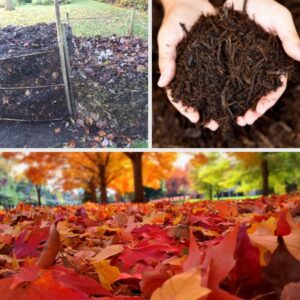
A forest floor blanketed with vibrant red, orange, and yellow autumn leaves, with trees displaying colorful foliage in the background.
Autumn is my favourite time of year. The leaves turn into a beautiful array of colours before falling to the ground, and while some might see these leaves as a chore, I see them as a treasure. Over the years, I’ve discovered the incredible benefits of collecting autumn leaves and turning them into leaf mulch for my garden. This mulch has been particularly beneficial for my beloved rhododendrons.
Just before the leaves start to fall, I always dedicate time to a thorough weeding session in the garden. By tackling the weeds beforehand, I ensure that when the leaves drop or the mulch is applied, it effectively prevents any weed seeds from reaching the surface. Let me share with you why I collect leaves every autumn and how you can create your own leaf mould pit.
Why Collect Autumn Leaves?
Suppresses Weeds: One of the best things about leaf mulch is how effectively it suppresses weeds. When I spread a thick layer of leaf mulch around my garden, it prevents sunlight from reaching weed seeds, reducing their growth. This means less time weeding and more time enjoying my garden.
Retains Moisture: Leaf mulch helps retain soil moisture by reducing evaporation. During dry spells, I’ve noticed that my plants, especially rhododendrons, stay healthier because the mulch keeps the soil consistently moist.
Improves Soil Structure: As the leaves break down, they turn into leaf mould, a rich, crumbly material that significantly improves soil structure. This makes the soil more porous and better at holding moisture and nutrients, which is perfect for rhododendrons.
Provides Nutrients: While leaf mulch doesn’t provide as many nutrients as compost, it still releases small amounts of essential nutrients as it decomposes. This slow release supports the healthy growth of my plants.
Enhances Soil Microbiology: Decomposing leaves encourage the growth of beneficial microorganisms in the soil. These microbes are vital for breaking down organic matter and making nutrients available to plants.

Three-part image: top left shows a compost pile in a garden, top right displays hands holding rich compost, and bottom shows a ground covered in colorful autumn leaves used as leaf mulch.
How to Create a Leaf Mould Pit
Creating a leaf mould pit is a simple process that I find incredibly rewarding. Here’s how I do it:
Choose a Location: I pick a shady, out-of-the-way spot in my garden. It should be well-drained to prevent waterlogging.
Prepare the Area: I mark out a space about 1 meter by 1 meter. Sometimes I dig a shallow pit, other times I use wire mesh or wooden planks to create a contained area.
Collect Leaves: I gather leaves from my garden, using a mix from different trees for a variety of nutrients. I avoid leaves that are diseased or treated with chemicals.
Fill the Pit: I place the collected leaves in the pit, layering them with a bit of garden soil or compost to speed up decomposition.
Moisten the Leaves: Lightly watering the leaves helps kickstart the decomposition process. They should be damp, not soaking wet.
Turn the Pile: Every few months, I use a garden fork to turn the leaves, aerating the pile to speed up decomposition.
Wait and Use: It can take 6 months to 2 years for the leaves to decompose into leaf mould. Once they’ve turned into a dark, crumbly material, it’s ready to use.
Using Leaf Mould in Your Garden
For my rhododendrons, I spread a layer of leaf mould around the base of the plants, careful not to pile it against the stems. This mulch keeps the roots cool, retains moisture, and slowly releases nutrients, creating an ideal growing environment.
Collecting autumn leaves and making leaf mulch is an eco-friendly, cost-effective way to improve your garden’s health. Not only does it benefit my rhododendrons, but it also supports sustainable gardening practices. So this autumn, instead of discarding those fallen leaves, give them a new purpose in your garden. Trust me, your plants will thank you.
